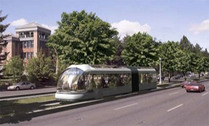Arlington ditching streetcar, will build “modern BRT”
This article was posted as an April Fool’s joke.
Arlington County officials announced today that they have decided to cancel plans for a streetcar on Columbia Pike, after revelations first reported in the Washington Post that higher-quality transit which moves more people, stimulates economic development, and enables preserving affordable housing also requires the use of “dollars” by the county.
Instead, the county will build a “modern BRT” system with low-floor buses, fare payment at the stop before riders board, signal priority, and platforms allowing level boarding with no gaps.
“The first two studies, in 2005 and 2012, considered and rejected a bus alternative as not having enough capacity for the ridership on Columbia Pike,” said county transportation director Bacchus Seep, “but when we looked again a third time, we realized for the first time that buses are cheaper.”
The program will slightly resemble the very successful BRT in Eugene, Oregon, which runs in dedicated lanes and highway medians. However, Arlington’s system cannot run in a dedicated lane, as an agreement with the Virginia Department of Transportation (VDOT) prohibits Arlington from reducing the number of general traffic lanes.
“I never realized the picture of a Eugene bus, prominently plastered across websites, wasn’t what we could get here in Arlington if we built BRT,” said ArlNow commenter “Piker,” who opposed the streetcar plan. “I don’t like this new BRT plan either. Everyone who came up with it should be fired.”
Group forms to oppose new BRT plan, says it’s too expensive
Following the news, the group Arlingtonians for Sensible Transit changed its name to Arlingtonians for Sensibler Transit (ASerT) and immediately blasted the new bus plan, saying that it would be “too expensive,” had not undergone enough analysis, and that a regular bus would be more cost-effective.
“The so-called ‘modern BRT’ alternative that Arlington County is now considering is a waste of taxpayer dollars,” said Paul Rousselittle of ASerT. “The low-floor buses, off-board fare payment, and signal priority which AST recommended are unnecessary as they do not add capacity along the Columbia Pike corridor.”
Board member Harvey Glibbey also criticized the BRT plan as unrealistic. “A number of these [BRT] lines are not performing as advertised,” said Glibbey. “In many cases, ridership is much lower than anticipated, costs are much higher.”
In response to the pushback, officials promised to conduct a fourth study to determine whether rapid buses are the most cost-effective mode. That study will analyze whether to scrap the BRT plan and replace it with a set of regular buses along Columbia Pike with their own branding, tentatively dubbed “Pike Ride.”
“That is a good start,” said Glibbey, “but I question whether we need the separate branding, as that brings extra marketing and painting cost. This new study is a good step, but needs another alternative where the buses have no names or identifying marks at all and riders simply ask the driver which bus it is when the bus arrives at a stop.”
Glibbey also recommended the county save on costs by not printing any maps.


